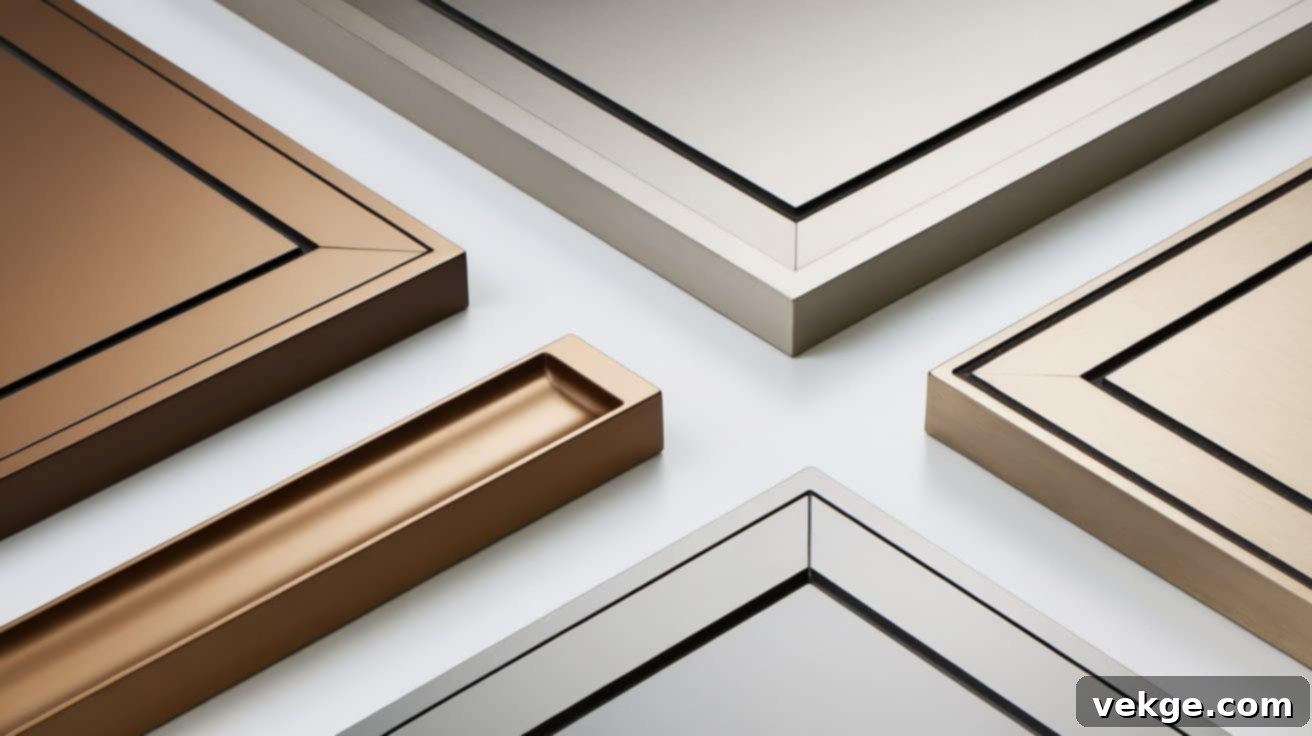Elevate Your Home: A Comprehensive Guide to Choosing the Best Interior Door Thresholds
Often overlooked, the small strips nestled at the bottom of your interior doors, known as interior door thresholds or door sills, are far more significant than you might imagine. These unassuming components play a pivotal role in your home’s comfort, energy efficiency, and overall aesthetic appeal. For many homeowners, the challenge lies in selecting thresholds that seamlessly marry practical functionality with harmonious design. Too often, individuals settle for options that either clash with their existing décor or fail to adequately address crucial practical needs like preventing drafts or creating smooth floor transitions.
If you’ve found yourself pondering which threshold is right for your space, you’re in the right place. This comprehensive guide will explore five of the most popular and effective interior door threshold styles perfectly suited for modern homes. We’ll delve into how each specific type can dramatically enhance your living environment, contribute to improved energy savings, and effortlessly complement your home’s unique design language. Let’s embark on this journey to explore these essential doorway solutions, empowering you to make the most informed decision for every entrance in your cherished home.
Understanding the Core Purpose of Interior Door Thresholds
Before diving into specific styles, it’s beneficial to understand why interior door thresholds are so vital. These small but mighty elements perform a variety of crucial functions. They define the boundary between rooms, provide a smooth transition between different flooring types, help seal the bottom of the door against drafts and pests, and even contribute to sound dampening. The right threshold can significantly impact your home’s comfort, efficiency, and safety, making their selection an important aspect of any home improvement project or new build.
Main Types of Interior Door Thresholds for Modern Homes
Interior door thresholds are available in a diverse range of styles, each meticulously designed to serve distinct purposes within your home. These often-underestimated components not only subtly enhance the visual appeal of your doorways but also play a critical role in their daily functionality. From effectively preventing energy-sapping drafts to expertly bridging disparate flooring materials, selecting the appropriate threshold can make a profound difference in your home’s overall comfort, efficiency, and long-term durability. Let’s explore the leading options that blend seamlessly with contemporary living.
1. Saddle Thresholds: The Classic and Versatile Choice
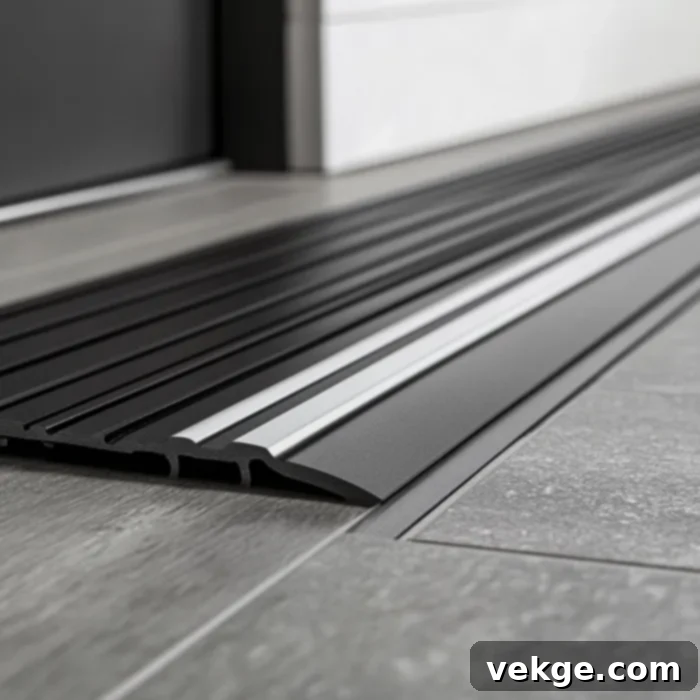
Saddle thresholds are arguably the most ubiquitous and enduring choice for homeowners, celebrated for their exceptional versatility and timeless, classic aesthetic. Characterized by a gentle, raised center that resembles a horse’s saddle (hence the name), these thresholds are adept at smoothly bridging subtle height discrepancies between adjacent flooring surfaces, preventing trips and providing a clean visual break. Beyond their transitional qualities, they also offer a degree of water management, acting as a minor barrier to prevent moisture from seeping under the door, particularly beneficial in areas prone to dampness or spills.
When you’re considering the installation of a saddle threshold, meticulous planning is key:
- Precise Measurement: Always measure the exact width of your door frame carefully to guarantee a snug and professional fit. An ill-fitting threshold can compromise both its function and appearance.
- Flooring Compatibility: Pay close attention to the height of the threshold in relation to your existing flooring. It should create a smooth, almost imperceptible transition without posing a tripping hazard.
- Material Selection: Choose a material that beautifully complements your door, flooring, and overall home décor. Popular and durable options include robust oak for a warm, traditional feel, sleek aluminum for modern minimalism, and elegant brass for a touch of classic sophistication. Each material offers distinct aesthetic and durability characteristics.
Maintenance Tip: To ensure your saddle thresholds remain both functional and visually appealing for years to come, incorporate regular cleaning into your routine. For wooden thresholds, occasional sealing or a fresh coat of varnish will protect the material from wear and moisture, significantly extending their lifespan and maintaining their pristine appearance.
2. Bumper Seal Thresholds: The Energy Efficiency Champion
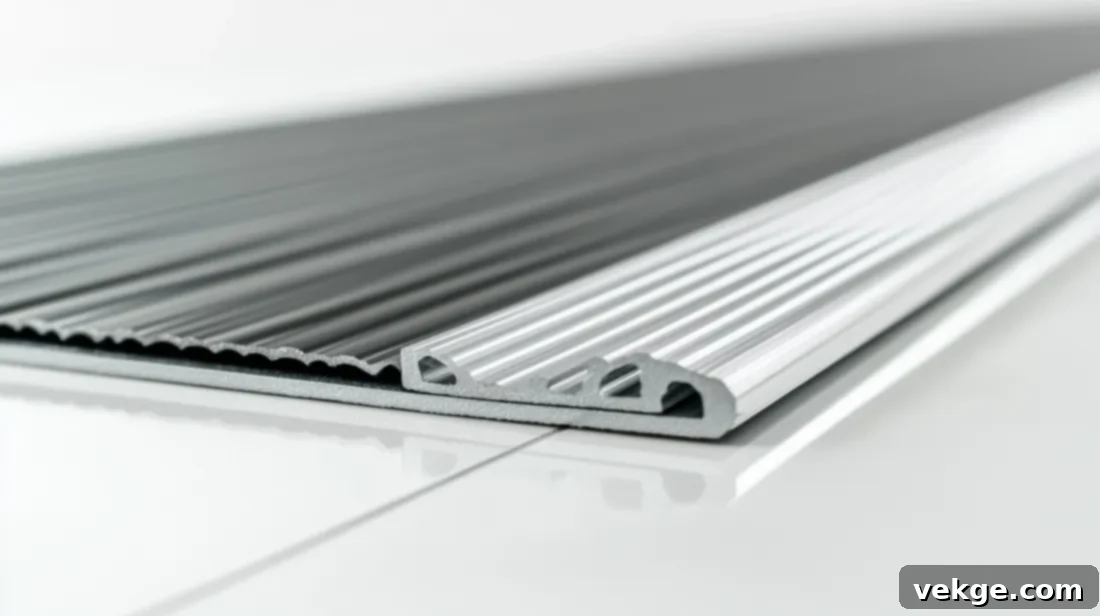
For homeowners prioritizing energy efficiency and comfort, bumper seal thresholds stand out as an exceptional choice. These ingenious thresholds are engineered to create an incredibly tight and effective seal when the door is in its closed position. This superior sealing capability makes them remarkably effective in several crucial areas within your home:
- Reduced Energy Costs: By creating an impenetrable barrier against air leaks, bumper seal thresholds dramatically reduce heat loss during colder months and prevent cool air from escaping during warmer seasons, leading to noticeable savings on your energy bills.
- Superior Protection: They act as an excellent defense against unwanted intrusions, effectively keeping out dust, dirt, insects, and small debris, thus maintaining cleaner interior spaces.
- Enhanced Soundproofing: The tight seal also significantly dampens sound transmission between rooms, offering increased privacy and a quieter, more peaceful living environment, particularly beneficial for bedrooms, home offices, or media rooms.
When you’re in the process of selecting a bumper seal threshold, consider these essential factors:
- Door Undercut Compatibility: Carefully check the existing undercut beneath your door to ensure perfect compatibility with the threshold’s design and height. Proper alignment is crucial for an effective seal.
- Adjustable Seals: Opt for models featuring adjustable seals. This flexibility allows you to fine-tune the seal’s compression, accommodating minor seasonal changes in door fit or settling, thus maintaining optimal performance year-round.
- Seal Material Durability: Evaluate the durability of the seal material, especially for doors that experience high traffic. Materials like silicone or robust vinyl offer superior resilience and longevity compared to less durable alternatives.
Pro Tip: To achieve the absolute maximum effectiveness in insulating your doorways, consider pairing a high-quality bumper seal threshold with complementary weatherstripping applied around the entire perimeter of the door frame. This combined approach creates a comprehensive seal, drastically improving your home’s thermal performance.
3. Heavy-Duty Thresholds: Built for Resilience and High Traffic
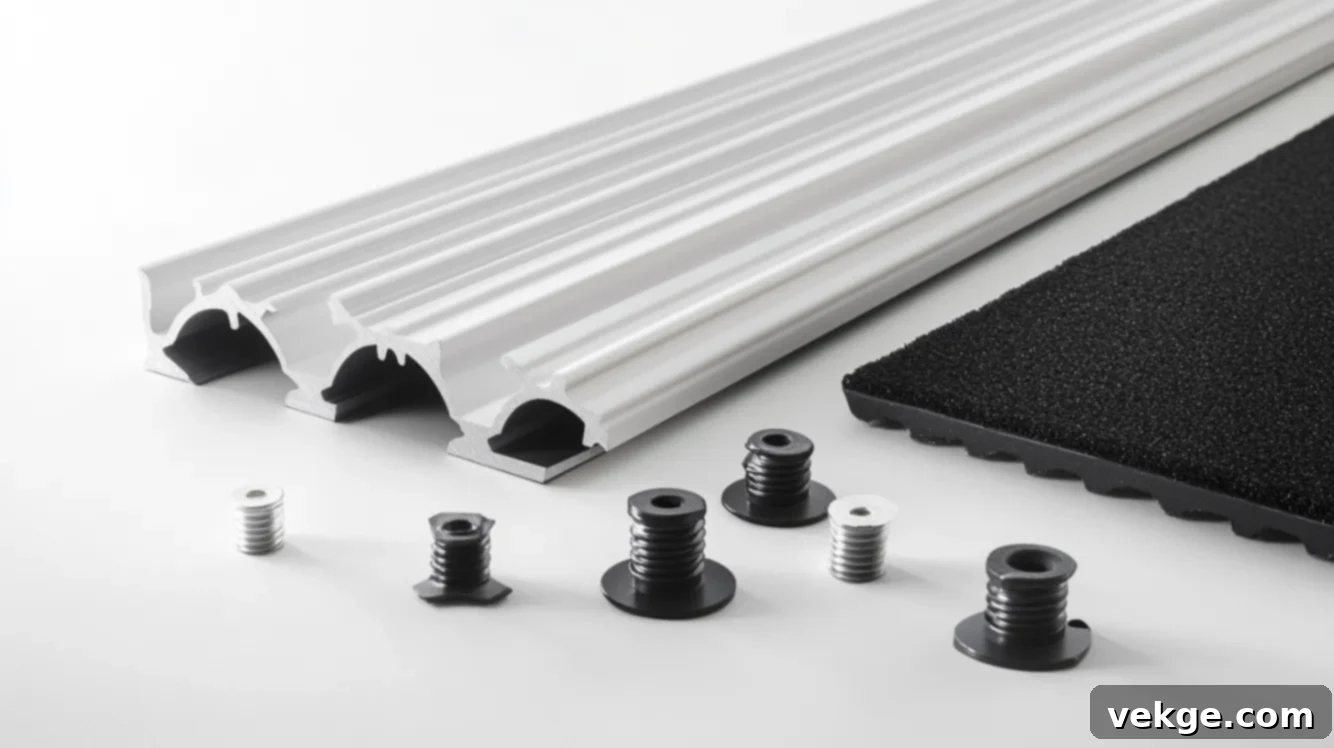
While often primarily associated with demanding commercial or industrial environments, heavy-duty thresholds are increasingly finding their rightful place and proving immensely beneficial in specific residential settings. These robust thresholds are engineered to withstand significant wear and tear, making them the ideal choice for areas within your home that experience unusually high levels of foot traffic, heavy equipment movement, or exposure to harsh elements. They offer unparalleled durability and longevity where standard thresholds might quickly deteriorate.
Heavy-duty thresholds are particularly well-suited for:
- Garage Entrances: Essential for garage doors, where they can easily endure the rolling of heavy equipment, tools, vehicles, and frequent pedestrian traffic without compromise.
- Mudroom Doors: Perfect for mudrooms, which act as crucial transition zones and are constantly exposed to dirt, moisture, and high volumes of foot traffic entering and leaving the house.
- Home Gyms: An excellent solution for home gyms or workshops where heavy weights, specialized fitness equipment, or machinery might be frequently moved across the doorway, preventing damage to the floor.
- Exterior-Facing Doors: Even though the article focuses on interior doors, some heavy-duty variants can be crucial for interior doors leading to high-exposure areas like screened porches or secondary utility entrances.
Key features to meticulously look for when selecting a heavy-duty threshold include:
- Slip-Resistant Surfaces: For enhanced safety, especially in areas prone to moisture or heavy use, choose thresholds with textured or grooved surfaces that provide superior traction and minimize the risk of slips and falls.
- Corrosion-Resistant Materials: If the threshold will be exposed to any form of moisture or varying temperatures (like in a mudroom leading outdoors), prioritize materials such as anodized aluminum or stainless steel, which offer excellent resistance to rust and corrosion.
- Height Adjustability: Certain heavy-duty thresholds offer height adjustability, a valuable feature that ensures a consistently proper fit even as floors settle or conditions change over time, maintaining optimal performance.
Remember: While paramount durability is the defining characteristic of heavy-duty thresholds, you absolutely do not have to compromise on aesthetic appeal. Many contemporary heavy-duty thresholds are now available in a wide array of attractive finishes and designs, allowing you to select an option that not only performs exceptionally but also beautifully complements your home’s existing decor, from industrial chic to modern utilitarian.
4. Thermal Break Thresholds: The Ultimate in Climate Control
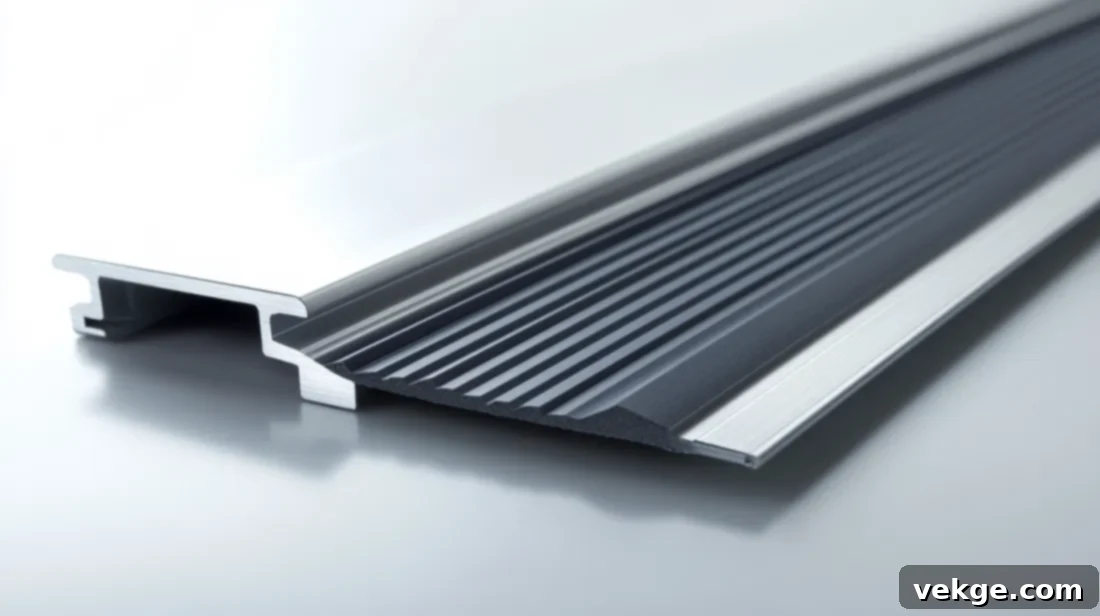
For environmentally conscious homeowners and those deeply focused on maximizing energy efficiency, thermal break thresholds represent an incredibly intelligent and sophisticated choice. These advanced thresholds are specifically designed to significantly improve your home’s thermal envelope, effectively minimizing unwanted heat transfer across the doorway. They achieve this remarkable feat through their unique construction:
- Creating a Thermal Barrier: Thermal break thresholds incorporate a non-conductive material (the “thermal break”) between two sections of a conductive material (typically metal). This barrier expertly severs the path for heat and cold to travel, creating a distinct separation between indoor and outdoor temperatures, or between a climate-controlled room and an unconditioned space like a garage.
- Reducing Heat Loss and Gain: By interrupting thermal bridging, they dramatically reduce heat loss from your home during the cold winter months and prevent excessive heat gain during scorching summers, leading to a more stable indoor climate and considerable energy savings.
- Minimizing Condensation: An added benefit of reduced temperature transfer is the significant minimization of condensation buildup. This not only protects your door and flooring from moisture damage but also actively inhibits the growth of mold and mildew, contributing to a healthier indoor environment.
When actively considering the integration of a thermal break threshold into your home, keep these critical points in mind:
- R-value Assessment: If available, diligently review the R-value (a measure of insulation effectiveness) of the threshold. A higher R-value indicates superior insulating properties.
- System Compatibility: Always check for seamless compatibility with your existing door system. Ensure the threshold integrates flawlessly with your door’s weatherstripping and sealing mechanisms for optimal performance.
- Professional Installation: Given the specialized nature and critical function of thermal break thresholds, considering professional installation is highly recommended. Expert installation ensures the thermal break is fully effective and that the threshold performs to its maximum potential.
Did you know that some thermal break thresholds are ingeniously designed to be combined with other functional types? For instance, you can find thermal break models that also incorporate elements of saddle or bumper seal designs, offering a multi-faceted solution for maximum efficiency and enhanced sealing capabilities, providing truly comprehensive climate control and protection.
5. Floor Dividers (Transition Strips): Blending Aesthetics and Function
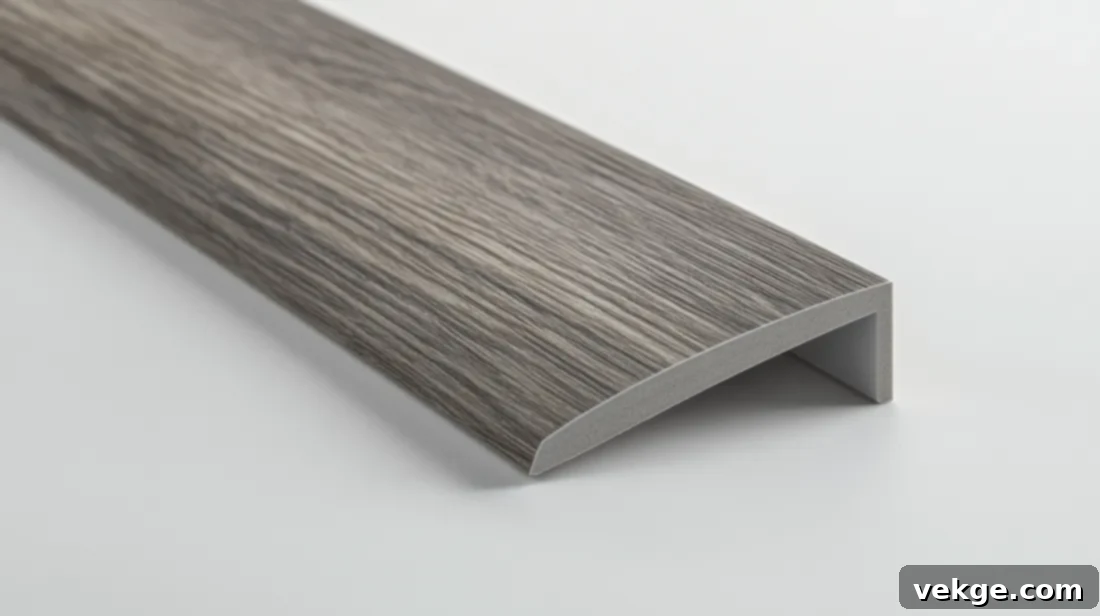
While often more subtle in their physical profile, floor dividers, also widely known as transition strips, are much more than mere functional components; they are increasingly recognized as an intrinsic design feature in their own right. These strips are indispensable for homes with varied flooring types, offering both aesthetic harmony and practical benefits. They elegantly manage the visual and physical transition between different materials, enhancing both safety and style.
Floor dividers serve several key roles in modern home design:
- Creating Visual Interest: They expertly delineate and define spaces, crafting clear visual boundaries between distinct flooring materials like hardwood and tile, or carpet and laminate. This can add a sophisticated design element to your home.
- Accommodating Expansion and Contraction: Critical for flooring longevity, floor dividers allow for the natural expansion and contraction of various flooring materials due to changes in temperature and humidity, preventing buckling, warping, and damage over time.
- Providing a Safe and Smooth Transition: They create a seamless, level, and safe transition for both foot traffic and wheeled devices (such as wheelchairs or cleaning robots), significantly reducing potential tripping hazards and improving accessibility.
Here are invaluable tips for selecting and flawlessly installing the perfect floor dividers:
- Match Thickness: Always match the height and profile of the divider to the exact thickness of your adjacent flooring materials. This ensures a truly flush and trip-free transition.
- Design Statement: Don’t shy away from considering wider or more visually prominent dividers if you aim to make a bolder design statement or want to emphasize the transition between areas. These can become intentional design elements.
- Material and Color Harmony: Seize the opportunity to use dividers as a chance to introduce complementary materials or colors that beautifully tie into your space’s overall design scheme. For example, a brass divider could echo brass hardware elsewhere in the room.
Design Idea: In contemporary open-concept homes, floor dividers can be masterfully employed to subtly yet effectively define different functional zones without the need for imposing walls. They guide the eye and suggest spatial divisions, contributing to an airy yet organized feel.
By thoughtfully and carefully selecting the most appropriate threshold for each unique doorway within your home, you possess the power to significantly enhance both the practical functionality and the intrinsic physical appeal of your entire living space. Remember, it is often these seemingly small, meticulously considered details that collectively make an enormous difference in your home’s overarching feel, long-term durability, and operational efficiency.
Additional Insights and Practical Tips for Choosing Door Thresholds
Choosing the ideal interior door threshold extends far beyond simply picking an attractive style. It’s a strategic process that involves a delicate balance between visual appeal and superior performance. To help you make the most informed decision, let’s explore several key factors and practical considerations essential when selecting thresholds that will truly optimize your home’s comfort and functionality.
Material Selection: Durability Meets Design
Interior door thresholds are fabricated from a diverse array of materials, each presenting its own unique set of strengths, aesthetic qualities, and maintenance requirements:
- Aluminum: Renowned for being lightweight, cost-effective, and inherently resistant to rust and corrosion. Aluminum thresholds are a popular choice for both residential and commercial applications, offering a clean, modern look and excellent durability. They are easy to clean and maintain, making them highly practical for various settings.
- Brass: Exudes timeless elegance and significant durability. Brass thresholds can add a touch of classic luxury and warmth to any doorway. However, they may require more consistent upkeep, such as occasional polishing, to maintain their lustrous shine and prevent tarnishing over time.
- Stainless Steel: An incredibly robust and long-lasting option, stainless steel thresholds are ideal for exceptionally high-traffic areas or environments where maximum strength and resistance to wear, impact, and corrosion are paramount. Their sleek, modern appearance integrates well with contemporary designs.
- Wood (e.g., Oak, Maple): Offers a natural, warm, and inviting aesthetic that can beautifully complement hardwood flooring or traditional décor. Wooden thresholds require more diligent maintenance, including periodic sanding, staining, or sealing, to protect them from moisture, scratches, and everyday wear, ensuring their beauty endures.
- PVC (Polyvinyl Chloride): A highly budget-friendly and remarkably easy-to-clean option. PVC thresholds are resistant to moisture and don’t rot, making them practical for areas like bathrooms or laundry rooms. However, they typically offer less durability and structural rigidity compared to metal alternatives, making them less suitable for extremely high-traffic zones.
- Rubber: Often used for its excellent sealing properties, especially in bumper seal thresholds. Rubber provides great flexibility, sound dampening, and resistance to weather, making it an effective choice for preventing drafts and impacts.
When making your material choice, always meticulously consider the specific environment and expected traffic levels for where the threshold will be used. For instance, in areas frequently exposed to moisture, such as bathrooms or entrances from a garage, metals like aluminum or stainless steel will undeniably prove to be far more resilient and practical choices than wood, which can be susceptible to water damage and rot.
Functionality and Purpose: More Than Just a Strip
The role of interior door thresholds extends far beyond merely filling a gap at the bottom of a door. Their intelligent design allows them to serve multiple critical functions that enhance your home’s livability and efficiency:
- Draft Prevention and Improved Insulation: A well-fitted threshold, especially those with integrated seals, acts as a barrier against unwanted air currents, significantly reducing drafts and helping to maintain consistent indoor temperatures. This directly contributes to better insulation and lower heating and cooling costs.
- Noise Reduction Between Rooms: Thresholds, particularly those with bumper seals, can effectively reduce sound transmission from one room to another. By creating a tight seal at the base of the door, they help dampen ambient noise, offering greater privacy and a quieter home environment.
- Prevention of Water Seepage: In specific applications, such as separating a bathroom from a hallway or an indoor space from a garage, thresholds can act as a crucial barrier to prevent water from seeping underneath the door and damaging adjacent flooring. Saddle thresholds, for example, offer this protective quality.
- Floor Protection and Transition: Thresholds protect the edges of different flooring materials from wear and tear, preventing fraying or chipping. They also create a smooth, finished transition between disparate surfaces.
For superior insulation and advanced soundproofing, prioritize options like bumper seal thresholds or thermal break thresholds. Furthermore, it is absolutely essential to consider accessibility. If your household requires smooth transitions for wheelchairs, walkers, or wishes to proactively minimize potential tripping hazards, actively seek out thresholds that adhere to ADA (Americans with Disabilities Act) guidelines. These typically feature very low profiles or gently sloped designs to facilitate easy passage.
Design and Visual Integration: Seamless Style
Your chosen threshold should not only perform flawlessly but also seamlessly integrate with your home’s overarching aesthetic. It should feel like an intentional part of your design, not an afterthought. Here are some thoughtful tips for achieving perfect visual harmony:
- Color Matching: Strive to match the threshold’s color and finish to your existing flooring, the door frame, or even surrounding wall trim. This creates a cohesive and polished look that ties the space together.
- Finish Consistency: Consider the finish – whether matte, glossy, brushed, or polished – and how it aligns with other hardware and fixtures in your home. A consistent finish contributes to a sophisticated and unified interior.
- Blend or Stand Out: Decide whether you want the threshold to subtly blend into the background or to serve as a distinct, eye-catching design element. A contrasting material or a wider divider can intentionally draw attention and define a space.
- Profile Consideration: The profile (shape and height) of the threshold should complement the style of your door and the surrounding architecture. A sleek, low-profile threshold might suit a minimalist home, while a more ornate saddle could enhance a traditional interior.
For those desiring a truly unique touch that perfectly matches a bespoke design vision, some specialized manufacturers and craftsmen offer custom-designed thresholds, allowing you to achieve a truly one-of-a-kind look for your distinguished home.
Installation Factors: Precision and Planning
Before committing to a purchase, it’s crucial to evaluate the installation requirements and your capacity to meet them:
- DIY vs. Professional Installation: Determine whether you possess the necessary skills and tools to confidently install the threshold yourself, or if securing professional assistance would guarantee a better, more accurate outcome. Complex thermal break thresholds, for instance, often benefit from expert installation.
- Fit and Compatibility: Rigorously confirm that the chosen threshold will fit impeccably with your existing door frame and the specific type of flooring on either side. Accurate measurements are non-negotiable for proper function and appearance.
- Special Tools and Preparations: Investigate if any specialized tools (e.g., miter saw for wood, specific adhesive for metal) or preparatory steps (e.g., leveling the subfloor) are required for a successful installation. Adequate preparation prevents headaches down the line.
- Subfloor Condition: Ensure the subfloor beneath the threshold area is clean, level, and structurally sound. Any irregularities can compromise the threshold’s stability and effectiveness.
Remember, proper fitting and meticulous installation are absolutely crucial not only for the threshold to function effectively as intended but also for it to maintain its aesthetic appeal over the long term. A poorly installed threshold can lead to drafts, damage, and an unsightly appearance.
Maintenance and Upkeep: Longevity and Luster
Different threshold materials necessitate varying levels and types of care to preserve their condition and performance:
- Metal Thresholds (Aluminum, Brass, Stainless Steel): Generally low-maintenance. They typically require regular dusting and occasional wiping with a damp cloth and mild soap to remove dirt and grime. Brass may benefit from periodic polishing to prevent tarnishing and maintain its shine.
- Wooden Thresholds: Require more attention. They should be cleaned regularly and protected from excessive moisture. Depending on the finish, they might need periodic sanding and resealing with a wood sealer or varnish to prevent water damage, scratches, and wear.
- PVC and Rubber Thresholds: Very easy to clean. A simple wipe-down with mild soap and water is usually sufficient to keep them looking new. These materials are highly resistant to moisture and most common household cleaners.
- Insulated Thresholds (Bumper Seal, Thermal Break): Regularly inspect the seals for any signs of cracking, hardening, or deterioration. Damaged seals should be replaced promptly to maintain energy efficiency.
Make it a habit to inspect your thresholds regularly for any discernible signs of wear and tear. This includes checking for gaps forming, any looseness in their attachment, or visible damage to the material. If you observe any of these issues, it is a clear indication that it might be time for a repair or, more likely, a full replacement to ensure continued functionality and safety.
Final Thoughts on Choosing the Perfect Interior Door Thresholds
As we’ve explored, the seemingly small decision of selecting the right interior door threshold can genuinely make a substantial and positive difference in the comfort, energy efficiency, and overall aesthetic appeal of your home. We’ve navigated through five popular and effective styles—saddle, bumper seal, heavy-duty, thermal break, and floor dividers—each boasting its unique strengths and ideal applications.
It’s crucial to remember that the “best” threshold is inherently subjective; it’s the one that perfectly aligns with your specific needs, lifestyle, and the unique characteristics of each doorway. Take a moment to thoughtfully consider what matters most to you. Is your primary goal to effectively prevent energy-wasting drafts and enhance insulation? Are you looking for an elegant solution for seamlessly connecting different flooring types and creating smooth transitions? Or perhaps you require something exceptionally sturdy and robust to withstand the rigors of a high-traffic area or heavy equipment movement?
Whatever your priority may be, rest assured that there is a perfectly designed threshold available to precisely fit your requirements. Don’t forget to meticulously consider the material of the threshold and how its finish and profile will harmonize with your home’s existing décor and architectural style. A thoughtfully chosen and impeccably installed threshold not only performs its functional duties with excellence but also serves as a refined finishing touch that elevates the entire appearance of your doorways, making them look complete and polished.
Are you feeling inspired and ready to upgrade or install new thresholds in your home? Take a thoughtful walk around your living space and identify where these versatile and highly beneficial additions could bring the most value and improvement. Your beautifully defined floors, enhanced comfort, and notably lower energy bills will undoubtedly thank you for the investment!
